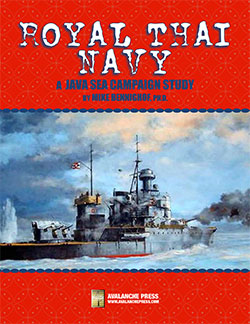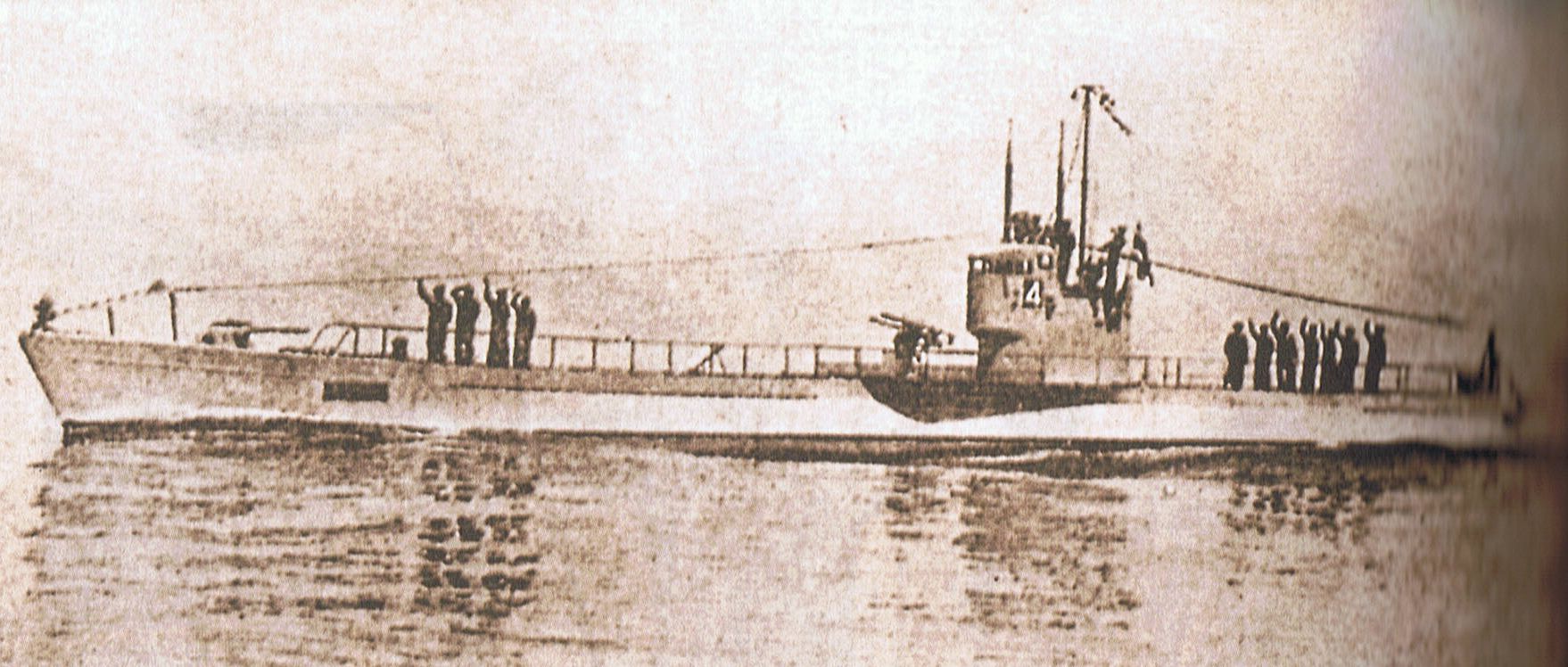| Java Sea: Royal Thai Navy
The King’s Ships, Part Two
by Mike Bennighof, Ph.D.
July 2024
 The story began with Part One. The story began with Part One.
Along with the “battleships,” as Songkhram always called them, the Navy ordered a pair of 1,400-ton sloops from Uraga Dock in Japan for use as training ships during peacetime and escorts in war. Tachin and Maeklong carried four 120mm guns and four torpedo tubes; though intended to carry a floatplane, they never received one. They patrolled the Bay of Bangkok during the war, but did not participate at Koh Chang. Tachin was sunk by Allied aircraft in 1945, while Maeklong survived the war, served as a training ship until 1996, and remains in existence as a museum ship.
Three 110-ton coast guard vessels (equipped to serve as slow torpedo boats in wartime) from Ishikawajima in Japan and two 370-ton minelayers built in Italy completed the surface component. The Thais also ordered four small coastal submarines from Mitsubishi. These arrived in 1938, along with Sri Ayuthia, with crews trained by the Japanese. They displaced just 374 tones, with a 76mm deck gun and for torpedo tubes, but lacked the range for extended operations.

The Royal Thai sloops Tachin (foreground) and Maeklong.
By the time of the Franco-Thai War, just two years after delivery, only two boats remained operable, and they played no role in that small conflict or the wider one that followed. After the 1951 naval mutiny that resulted in Sri Ayuthia’s sinking, the Thai Navy was stripped of its submarines and the boats lay unused at a cement factory for years before their scrapping.
Along with the new equipment, the Thais also constructed a modern new naval base at Sittahip, about 200 kilometers southeast of Bangkok. Their ships also spent time at Samut Prakan, Bangkok’s commercial port, and the Thais made heavy use of the roadstead at Koh-Chang, closer to the border with Indochina.
The “battleships” made a good impression on the dictator Songkhram, who approved Navy requests for more new ships. While the Thais initially wished to purchase a second pair of coast-defense ships, Kawasaki had no spare gun turrets lying around this time and the ships would have had to be constructed from the keel up. Even using the stock of discarded 200mm Type 3 gun barrels, this would have raised the cost of the ships, and the Thais began to look elsewhere.

His Thai Majesty’s Submarine Phlai Chumplon.
Italian shipyards offered good prices and easy credit, for customers willing to pay in hard currency (that is, money issued by a country with a stable economy), and the Thais had a small reserve of sterling to spend. Some of the Thai leadership apparently wished to order a second pair of Sri Ayuthia-class ships even at the higher price, but those wishing to develop a greater “blue water” capability won out and the Navy ordered a pair of small cruisers in the Italian yard Cantieri dell Adriatico in 1938, which had built the torpedo boats and minelayers.
The Thais had been much more satisfied with the mechanical reliability of their Italian-built ships, and this probably played a major role in steering their limited funds toward the cruiser program. Four more small submarines from Mitsubishi were authorized at the same time, but orders had not been placed when a war scare with France broke out in 1940.
As designed, the two cruisers had a standard displacement of 4,300 tons, eventually rising to 5,500 tons. They were “export’ versions of the Italian Montecuccoli-class light cruisers; the after boiler rooms and one gun turret were deleted from the Italian ship’s design, creating a profile that definitely resembles a crude cut-and-paste change to Montecuccoli’s elegant shape. The Thai cruisers Taksin and Naresuan would have six 152mm (six-inch) guns, the Italian Ansaldo Model 1929 carried by Montecuccoli (and therefore not interchangeable with the British-made six-inch guns of the armored gunboats). The heavy anti-aircraft battery would have been six obsolete Armstrong Model 1917 76mm guns, and eight 13.2mm Breda heavy machine guns would have provided the light anti-aircraft battery. The ship would also sport six 553mm Italian-made torpedo tubes (again, a different model than those carried by other Thai warships) and a catapult with two floatplanes.
The Thais did not specify the high speed of Italian cruisers, and their ship would have made 28 knots (some sources say 30 knots), allowing a much smaller power plant. She would have had two sets of Parsons turbines, producing 40,000 horsepower, less than half the output of the Italian cruiser. Montecuccoli clocked 37 knots, but at the cost of a huge set of boilers and turbines. The pair of slower, smaller cruisers carried a combined price tag much less than a single Montecuccoli.

Royal Thai cruiser Naresuan hits the waters of Trieste, 6 August 1941.
Like Italian cruisers, they would have minimal protection: an armored belt 60mm thick, and an armored deck of 30mm; it’s not clear what armor they would have on their conning tower and magazines but following Italian practice it probably would have been about 100mm. The turrets would be unarmored gunhouses.
The yard laid down the ships in August and September 1939, and when Italy entered the Second World War construction continued as long as the Royal Thai Navy made its payments. Not until December 1941 did the Royal Italian Navy take over the ships, redesigning them as anti-aircraft cruisers but never completing the work. The Germans seized the incomplete hulls in September 1943 and appear to have actually done some work on the cruisers before scuttling them in the general orgy of vandalism that accompanied their retreat from Italy.
The Royal Thai Navy absorbed a great deal of the kingdom’s limited funding, producing almost no results in return. Thai sailors proved themselves courageous at the Battle of Koh Chang, yet poorly trained in just about every category including the crucial skills of damage control – both coast-defense ships would be lost to fires that could not be contained despite having diesel propulsion, which should have mitigated against this risk. The Thais enforced no standardization on their weaponry or heavy machinery; their three classes of major warships (the gunboats, coast-defense ships and projected cruisers) sported three distinct varieties of propulsion (triple-expansion engines, diesels, and turbines), creating a training nightmare that would have been almost impossible for a tiny navy to overcome.
Thailand would not begin to rebuild her fleet for many years, and the ships built in the 1930s continued in service until the early 1970s, when the kingdom again embarked on an effort to build a modern fleet.
You can order Royal Thai Navy right here.
You can order Java Sea right here.
Sign up for our newsletter right here. Your info will never be sold or transferred; we'll just use it to update you on new games and new offers.
Mike Bennighof is president of Avalanche Press and holds a doctorate in history from Emory University. A Fulbright Scholar and NASA Journalist in Space finalist, he has published a great many books, games and articles on historical subjects; people are saying that some of them are actually good.
He lives in Birmingham, Alabama with his wife, three children, and new puppy. He misses his lizard-hunting Iron Dog, Leopold.
Want to keep Daily Content free of third-party ads? You can send us some love (and cash) through this link right here.
|
